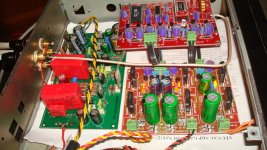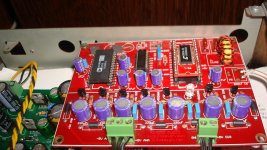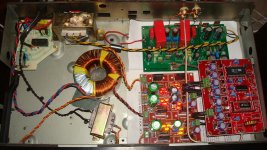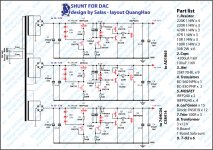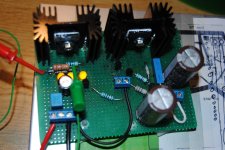Ricardo
If they can achieve more Vdrop than your current Leds, yes the total current will rise when keeping same R1. I see they state Vf 2.1. If they are also typical 10-20mA they are common. I see they are very expensive though. A bag of leds in nice price from some electronics shop does the job most of the times. Especially if they allow you to test one from the bag.
If they can achieve more Vdrop than your current Leds, yes the total current will rise when keeping same R1. I see they state Vf 2.1. If they are also typical 10-20mA they are common. I see they are very expensive though. A bag of leds in nice price from some electronics shop does the job most of the times. Especially if they allow you to test one from the bag.
I got 100pcs Siemens orange LEDs with about 2V vdrop for like, peanuts :S I like'em but I don't know if they're audiophile approved 😱
Ricardo
If they can achieve more Vdrop than your current Leds, yes the total current will rise when keeping same R1. I see they state Vf 2.1. If they are also typical 10-20mA they are common. I see they are very expensive though. A bag of leds in nice price from some electronics shop does the job most of the times. Especially if they allow you to test one from the bag.
In this case, Vf = 2,1 .... does it mean Vdrop should be 2,1V ?
The leds suggested in the DC B1 bom pdf available from Mouser have a Vf (typical) = 1.8 V and cost 9 eurocents each (+ 20% vat).
I'm going to place an order in few days, if you want I can increase the quantity and send them to Cascais.
I'm going to place an order in few days, if you want I can increase the quantity and send them to Cascais.
In this case, Vf = 2,1 .... does it mean Vdrop should be 2,1V ?
The ones you linked are so. I predict 230mA or so with 10R R1.
RCruz said:In this case, Vf = 2,1 .... does it mean Vdrop should be 2,1V ?
Vf=Voltage Forvard, not Voltage Drop
Example: Connect 3V to LED pins. Voltage at pins will be 2.1V, this is Voltage Forvard.
Nice board !
Would you please post a schematic that goes with the board so we can all follow your work ?
Ricardo
Ok! you can see some image my friend make with Salas shunt low!
thank
Attachments
Quanghao, tell your friend to reduce the lentgh of the black cables connecting the shunt board to the Dac pcb to the bare minimum. Those cables must be very short if you want to get fully advantage of the very low output impedance of the power supply.
Last edited:
Quanghao, tell your friend to reduce the lentgh of the black cables connecting the shunt board to the Dac pcb to the bare minimum. Those cables must be very short if you want to get fully advantage of the very low output impedance of the power supply.
Ok! thank Massimo!
Hi Salas
I bypassed the 10r R1 with a 47r and am now reading 250mA between the smoothing cap and the shunt... (I am testing the shunt without any load).
Is this the correct way to measure shunt´s working current ?
Regards
Ricardo
I bypassed the 10r R1 with a 47r and am now reading 250mA between the smoothing cap and the shunt... (I am testing the shunt without any load).
Is this the correct way to measure shunt´s working current ?
Regards
Ricardo
@RCruz
R1=10 Ohm, bypassed with 47 Ohm. Total resistance = 8.24 Ohm
Measure voltage drop across this paralleled resistor. Divide voltage with resistance to get current. For 250mA voltage drop should be approx. 2.06V
Parallel resistance Calculator
R1=10 Ohm, bypassed with 47 Ohm. Total resistance = 8.24 Ohm
Measure voltage drop across this paralleled resistor. Divide voltage with resistance to get current. For 250mA voltage drop should be approx. 2.06V
Parallel resistance Calculator
Last edited:
My measurements are 8.39r on R1, 1.99Vdrop on R1 so I calculated 0.237A... but measuring the current flow in the shunt input I get 0.25A.....All this without loading.
How can I explain the current diferences ?
Ricardo
How can I explain the current diferences ?
Ricardo
Last edited:
Probably 🙂
I settled for 10r//27r
Vdrop R1 = 1.964v
Current should be 265mA.
These are the measurements on the 4wire shunt I am now going to try !
It gets hot.... 76ºC on the power mosfet but I have good sinks.
Ricardo
I settled for 10r//27r
Vdrop R1 = 1.964v
Current should be 265mA.
These are the measurements on the 4wire shunt I am now going to try !
It gets hot.... 76ºC on the power mosfet but I have good sinks.
Ricardo
- Status
- Not open for further replies.
- Home
- Amplifiers
- Power Supplies
- The simplistic Salas low voltage shunt regulator

